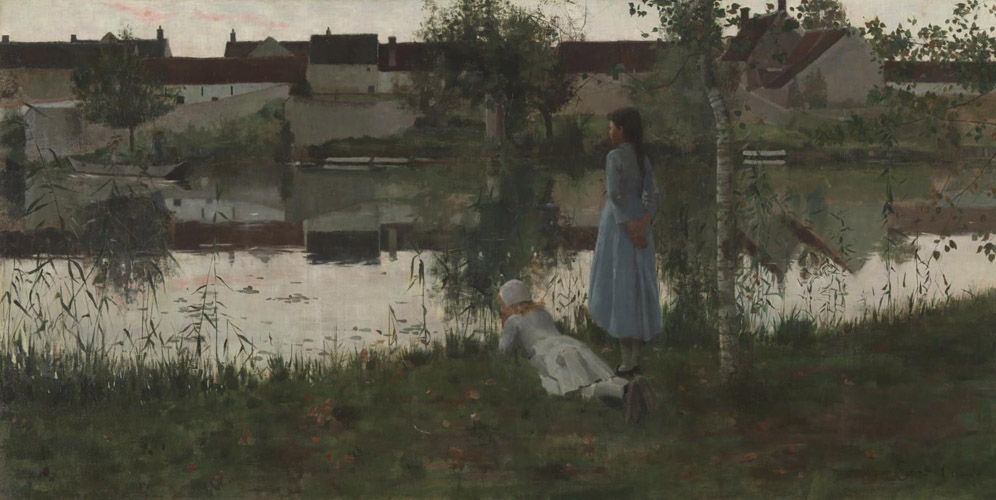|
WILLIAM STOTT OF
An Exhibition at Gallery
Reviewed by Charles Ashleigh
Was William Stott a great painter? The answer, I fear, has to be no,
he wasn’t. He could be a very good painter, as certain of the works
in this exhibition demonstrate, but he was extremely variable, and
some of his paintings seem uneven in intention and achievement. But
it may be a little unfair to rush to a judgement based on what is to
be seen in the current show.
The exhibition is largely meant to showcase what is often referred
to as Stott’s “masterpiece,” a large canvas called
The Ferryman. And it is a
very fine piece of work. It was painted while Stott was living in
the artists’ colony at Grez-sur-Loing in
There is no doubt that Stott was influenced by the time he spent in
As noted earlier, The
Ferryman is the centre of attention in the
Another equally attractive Stott painting is
Prince or Shepherd, in
which a young girl is looking into the distance, and is, it is
indicated, daydreaming about what life will bring her. It seems that
the picture has also had the title,
Girl in a Meadow, and I
have to say that I could happily live with that rather than have a
suggested interpretation of the girl’s thoughts thrust upon me.
However, whatever the title, there’s no doubt that Stott’s skill at
landscape painting is well in evidence.
If the two pictures I’ve mentioned have Stott at his best, a couple
of others show him to my mind in a less than successful llght. The
dreadful, The Birth of Venus,
perhaps ought only to be displayed because of the whiff of scandal
surrounding it. Stott had used Whistler’s mistress, Maud Franklin,
as the model for the nude Venus, and Whistler took offence when the
painting was exhibited in public, and broke off his friendship with
Stott. The pair even came to blows when they met in a
The other Stott painting that I thought tended not to show him to
good effect is The Two
Sisters, a fairly dull composition in which the two figures in
the foreground almost seem to have been superimposed on the scene as
an afterthought. They are rather like cardboard cut-outs placed on
the picture and consequently not properly blended into it. I had the
feeling that Stott had started a painting showing children playing
in the sand near the sea, decided it wasn’t enough, and then put the
two sisters there to try to add some substance to the scene. It
doesn’t work.
My strictures about a couple of Stott’s paintings should not deter
anyone from visiting Gallery Oldham, if only to look at
The Ferryman, and
Prince or Shepherd. There are several other Stott paintings
worth seeing. He was always at ease with landscapes, as he was with
seascapes, though they’re not much in evidence in this exhibition.
Paintings by some of Stott’s contemporaries, such as Walter Sickert,
George Clausen, and John Lavery, also make an appearance to help
place Stott in context.
I quoted from Roger Brown, and it’s worth noting that his book,
William Stott of Oldham
1857-1900: “A Comet Rushing to the Sun” (Paul Holberton
Publishing, London, 2003) was published in connection with an
earlier exhibition, William
Stott of Oldham, at
Gallery Oldham, 6th December,2003, to 24th April, 2004. I recall
visiting this exhibition and it gave a much wider picture of Stott’
work than the current one. Brown’s book still seems to be available
at the gallery and is worth buying.
|
